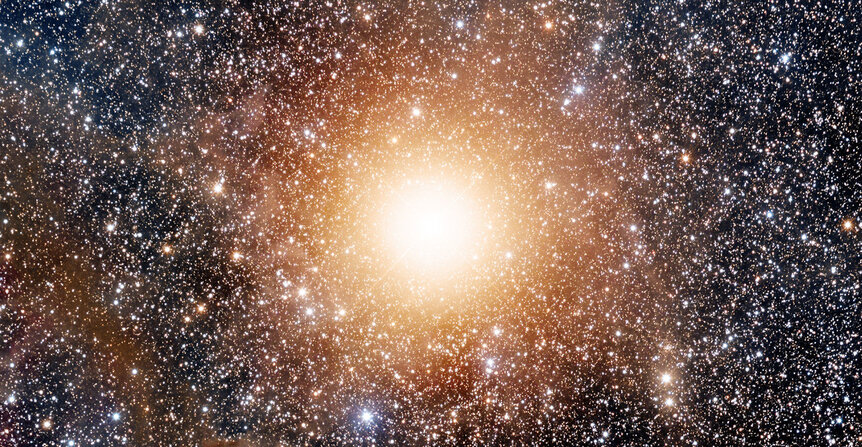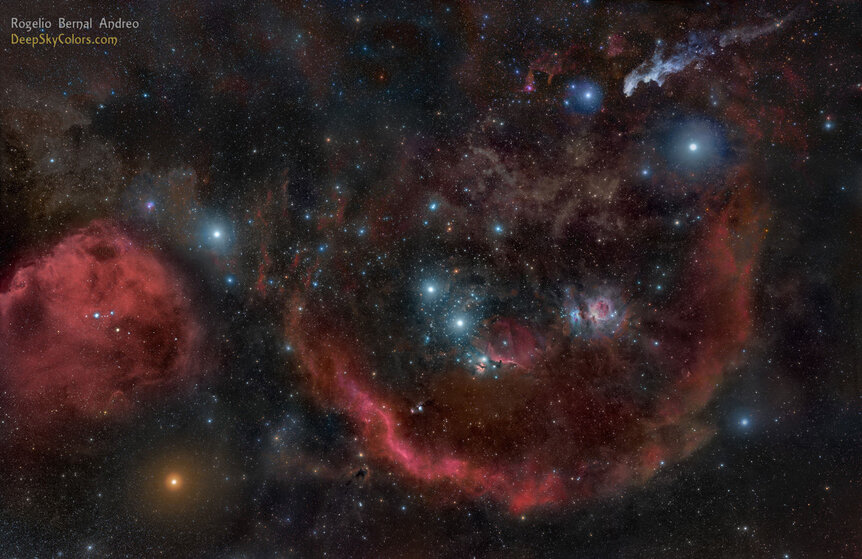Create a free profile to get unlimited access to exclusive videos, sweepstakes, and more!
B E T E L G E U S E

Oh, I could go on and on about how massive it is (15 times our own Sun's heft) or its tremendous luminosity (125,000 times more energetic than the Sun) or its overwhelming size (well over a billion kilometers across).
I could tell you about its color (orange-red due it being much cooler than the Sun) or its youth (roughly 9 million years, a tiny fraction of the Sun's 4.6 billion year life so far) or its distance (650 light years, 6.5 quadrillion kilometers).
I could also tell you how it could explode (but it won't for 100,000 years or so).
But I have a better idea. I've heard that if you say its name three times it'll appear.
This is a science blog, so let's see:
Betelgeuse.
Betelgeuse.
Betelgeuse.
Huh. How about that?
Isn't that lovely? That is indeed the star Betelgeuse, marking the right shoulder (or armpit) of the constellation Orion, a massive, luminous, enormous red supergiant. In almost every image I've seen of it the exposure is such that few stars are seen around it; the star is so bright by eye (in the top 15 brightest stars in the sky usually) that short exposures are needed or else it swamps the image.
But astronomer and accomplished astrophotographer Adam Block was able to create this masterpiece using a small (but very fine) telescope in a 4.5 hour total exposure — 1.5 hours each using red, green, and blue filters. The result is a natural color image of this amazing star.
There's also much to see in this that's not Betelgeuse. The image is about 4° on a side — eight full Moons could fit across it — and it's filled with stars. It took me a while to get my bearings, but (for example) I was finally able to ID the star to the upper left as 52 Orionis, a star visible to the naked eye from a dark site.
But even the stars take a back seat to the incredible display of gas and dust. The entire constellation of Orion (and beyond its borders) is, from our vantage point and distance on Earth, filled with the Orion Molecular Cloud Complex, a vast series of dense, cold hydrogen clouds where stars are forming at prodigious rates. The spectacular Orion Nebula, so close and bright it's easily visible to the naked eye, is just one small piece of this sprawling nebulosity.
Adam's shot shows detail of this, with brownish dusty clouds like splotches against the redder glow of warm hydrogen. 52 Ori is actually a binary star, each component hotter and more massive than the Sun, making them blue. You can see a faint blue fog around them caused by dust scattering their light toward us, a cheerful contrast to the darker duskier tones around it.
Betelgeuse was in the news a lot recently due to its shenanigans, dimming by such a considerable amount that it was obvious by eye. It's now back to its usual ruddy glow, and what happened exactly isn't clear (though it certainly involves the eructation of a vast amount of opaque dust from its upper atmosphere that blocked our view of it).
From this image you'd never know it could ever be anything less than ostentatiously prominent. Of course, in a hundred millennia or so it will become very much more obvious, when its core collapses and its outer layers explode outward at a significant fraction of the speed of light, and even from our great distance it will outshine Venus. When Betelgeuse goes supernova, it will be anything but subtle.
That lies in the distant future, though. For now, we can still enjoy it as one of the most brilliant, and one of the most exquisite, stars in the sky.





























